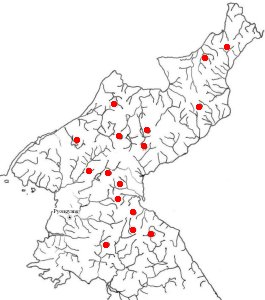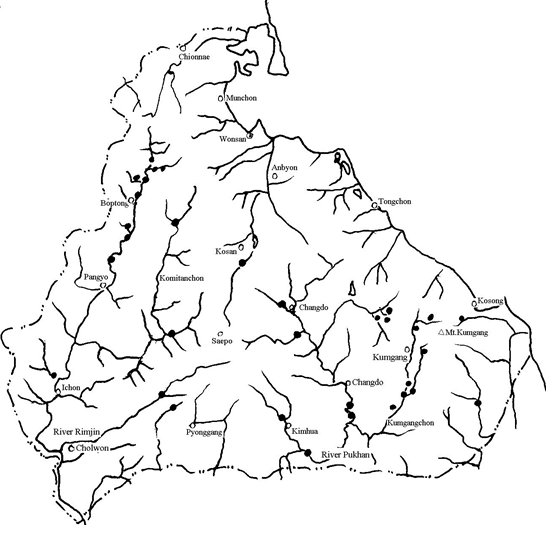IUCN/SSC Otter Specialist Group Bulletin

|
©IUCN/SCC Otter Specialist Group Volume 28A Proceedings Xth International Otter Colloquium, Hwacheon, South Korea Citation: Ryol, C. J. (2011) Distribution, Ecology and Conservation of the Common Otter (Lutra lutra) in DPRK (North Korea). Proceedings of Xth International Otter Colloquium, IUCN Otter Spec. Group Bull. 28A: 167 - 172 Distribution, Ecology and Conservation of the Common Otter (Lutra lutra) in DPRK (North Korea) Chong Jong Ryol 1 |
|
Abstract: Waiting for an abstract |
|
Keywords: Lontra longicaudis; microsatellite loci; noninvasive sampling; population dynamic; phylogeographic studies |
| Française | Español |
INTRODUCTION
The Red Data Book of DPRK says that the otter belongs to the category of vulnerable species (VU) and suffers from a serious decrease in its numbers recently, although it was widely distributed in the middle and upper parts of rivers all over the country in the past. Therefore, the protection of the otter and its habitat is one of the important issues for species diversity conservation.
DISTRIBUTION
Our country has many rivers and streams with a high density of 0.4-0.6km/km2.
There are about 6590 rivers and streams longer than 5km in the whole of the Korean Peninsula.
At present, otters are found on the Chungman, Jasong, Chongchon, Taedong, Ryesong, Rimjin, Pukhan, Chongjin-Susong, Tuman, Kilju-Namdae, Songchon, Kumya and Tokji Rivers.
Otters are also confirmed to be inhabiting Jangjin and Pujon Lakes and the Munchon Reservoir (see Figure 1 ).
 |
| Figure 1. Water bodies inhabited by otters. Click for larger image |
The 2002-Survey in Kangwon Province showed that otters were distributed in several areas of the upper parts of the Rimjin and Pukhan Rivers.
Otter distribution in Rimjin River covers 9 villages in Pobdong County, including Ryungdong, Ryongpo, Majon, Tochan, Ryongjo, Paekil, Eryu, Kumgu and Rotan, centering on 3 places: Hwangso between Tochan ri and Ryongjo ri, Ryongbawiso between Eryu ri and Rochan ri, and Haekgolkaetang in Paeil ri.
Otters are also found in Kudang ri of Pangyo County, Songbuk ri of Ichon County and the Komitan branch of the Rimjin River.
The distribution in the upper part of Pukhan River covers:
- The Inner Kumgang area of Mt. Kumgang including Pyongmu ri, Tanpung ri, Kumchon ri, Hyon ri, Sogon ri, Hyondong ri, Hahoi ri, Anmi ri, Sedong ri and Pungmi ri;
- Wonbuk ri and Ryonghyon ri of Kimhwa County, Singye ri and Pongpo of Hoiyang County, Ibnang ri and Myonchon ri of Changdo County;
- Pupyong ri and Sinhyon ri of Kosan County, Onjong ri, Unjon ri and Wolbisan ri of Kosong County, etc ( Figure 2 ).

|
| Figure 2. Distribution of otters in Kangwon Province. Click for larger image |
The above findings in Kangwon Province suggest an increase in otter distribution during the countrywide surveys on each water system.
However, the survey in Kangwon Province also showed a limited amount of habitat fulfilling the otter’s ecological demand and small and fragmented populations, despite the large number of inhabited sites.
There are more than 15 otters in the upper water system of Rimjin River and 20-30 in the upper part of Pukhan River, with a total of between 50 and 35-45 estimated otters in the Kangwon area, based on observations on the Pobdong Reserve and the opinion of the residents in each country etc.
The earlier survey conducted in 1992-1993 reported about 10 otters in Pobdong Reserve, 20 in Tokchon, Sinyang and Yangdok areas in the upper part of Taedong River, 10 in Sudong, Yodok and Jongpyong areas, 6 in the upper Songchong River, 4 in the upper Kumya River and 5 in the middle stretches of Chongchon River (in the Mt. Myohyang area), showing the same tendency as the present survey in Kangwon Province in several respects including the small size and fragmented nature of the population and the difficulty of contact between them.
ECOLOGY
In general, otter habitat in the Kangwon area were located in sites which included deep swamps in a bend of a river with lots of big rocks along the banks, providing denning sites, plenty of water, and in particular, dense vegetation cover allowing the animals to hide quickly and easily at any time.
The habitat used on Mt. Myohyang had the same environmental conditions.
No signs of otter were found in areas with sandy or muddy bottoms and open basins.
The feeding places of the otters were situated on large rocks, in cracks in cliffs or on very coarse gravels, where scat was found. Scat analysis showed the diet included fish, crustaceans, insects, shellfishes and in particular crayfish.
We observed that on Mt Myohyang, otters left their dens from 30 minutes to an hour after sunset, excreted and then began hunting, causing great damage to a nearby fishpond.
In Ryuldong ri in Pobdong County, a young otter was seen vocalising on a rock at about 11 am on a cloudy and rainy day.
In reservoirs, otters were mainly seen in areas of rapids.
PROTECTION
Three living monument reserves are established as follows;
- No 55 for Taehung Otters (on the upper part of the Taedong River in Taehung County of South Pyongaan Province)
- No 249 for Pobdong Otters (on the upper Rimjin River in Pobdong County of Kangwon Province)
- No 331 for Sinyang Otters (on the branch of the Tuman River in Sinyang District of Yonsa County of North Hamgyong Province)
The protection of living monuments for otters requires the enhancement of the role of keepers and organizational work of the Bureau for Conservation of Cultural Relics.
Among the higher animals in our country, there are only 2 species with the letter “Dal” in their Korean names: the otter (Lutra lutra) and the yellow-throated marten (Martes flavigula). These species have been well known as furbearers from ancient times. In particular, many legends have been told of the otter.
In order to improve and strengthen the conservation of the otter, it is necessary to conduct regular nationwide surveys of its distribution, thus guiding measures for in-situ conservation of otters in its most populous areas as well as in the current living monument reserves.
At present, the major threats to otter are overhunting of the species itself (generally poaching), consequent instability of population, destruction of habitat and in particular habitat and population fragmentation.
Otters have a close relationship with the water system and so it is very important to conserve biodiversity in inland water ecosystems.
Our country has a great average annual precipitation resource, exceeding 1000mm/year, but its distribution shows great differences in regions and seasons. The distribution centers on the upper parts of Chongchon, Taedong, Rimjin and Puhan Rivers, which frequently receive heavy rain and therefore have great quantity of water compared to other water systems.
From the meteorological data, the summer wind direction in our country is mainly SW and SE, and precipitation centers are located in areas where the slope of mountain range faces those air currents. In particular, the heaviest rain is found in trumpet-shaped valleys surrounded by high mountain range on 3 sides and opened towards the wind direction.
On the east coast, a high, steep mountain range runs nearly parallel to the, and experiences heavy rainfalls caused by forced airflow up slopes facing north-est andsouth-east winds.
In South Hamgyong Province, the heavy rain centers on the Yodok and Kumya areas, and this coincides with otter distribution.
Therefore, in order to solve two issues, namely provision of sufficient water in otter habitat, and to reduce derangement of river ecosystems by heavy rain, it is necessary
- to put special emphasis on the improvement of basin management, in particular the forestation on slopes,
- to raise the efficiency of the forest’s ability to sustain the water system and prevent erosion, and
- to conduct an investigation into the protection of the otter’s habitat and the prevention of habitat fragmentation due to the above factors.
The conservation of otter requires following actions:
- To conduct further conservation-biological research on otters, especially a Population viability analysis (PVA) including the limit of safety for maintenance of major habitats and population existence, the duration of protection program, and in particular, prevention of loss of genetic mutation on the condition of current population size.
- To take following measures for ex-situ conservation;
- Set up reserves of sufficient size in areas of good otter habitat for conservation, in addition to the current living monument reserves for otter
- Design ecological corridor between habitats
- Create breeding facilities for otter in reserves
- Construction facilities for ex situ breeding of otter in both the Central Zoo and Wonsan Zoo Park
- To raise residents’ understanding of legal requirements and enhance the spirit of their obeying existing laws related to the distribution of otter including;
- Law on Conservation of Useful Animals (1998)
- Law on Protection of Scenic Spots and Living Monuments (1995)
- Law on Environmental Protection (adopted in 1986, revised in 2000)
- Law on Environmental Impact Assessment (2006)
- To design and manage otter reserves enabling the local residents to get both eco-environmental benefit and socio-economic one from those designations. For this purpose, it is important
- to pay preferential attention to the conservation of inland ecosystems in otter reserves
- to create forests of great economic value including edible fruit-bearing forests and firewood forests
- to construct specific reserve industries, thus closely combining the enhancement of regional economies with the improvement of people’s livelihoods.
REFERENCES
Won Hong Gu (1968). Book of Higher Animals in Korea, Publishing House of Academy of Sciences
Jin Yong Muk and Ri Sang Ryul (1978). Nature Reserves in our Country, Agricultural Publishing House, 207
Ri Jun Bom et al (1989). Encyclopedia of Korean Topography (Zoological One), Educational Publishing House, 381
Kim Kye Jin (1987). Zoogeographical Study on the Land Mammalians in our Country, 114
Pak U Il (1999). Diversity of Bio-species in our Country, Scientific Encyclopedia Publishing House, 207
Pak U Il and Kim Man Sob et al (2002), Threatened and Rare Species in our Country, MAB National Committee
Pak U Il and Hwang Song Rin et al (2003). Biodiversity of Mt. Kumgang, MAB National Committee, 309
Pak U Il et al (2005). Nature Reserves in our Country, MAB National Committee, 155
Résumé:
Nous attendons un résumé
Revenez au dessus
Resumen:
Estamos a la espera
de
un resumen
Vuelva a la tapa